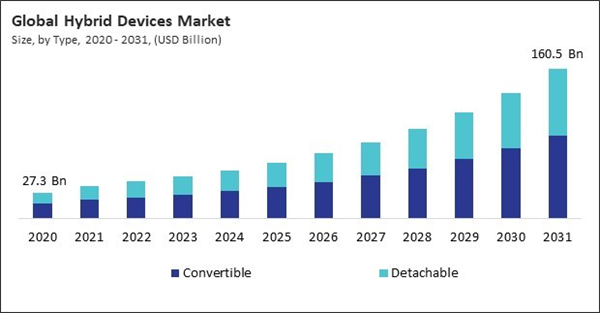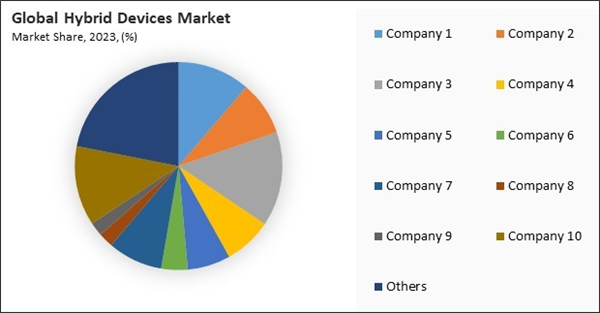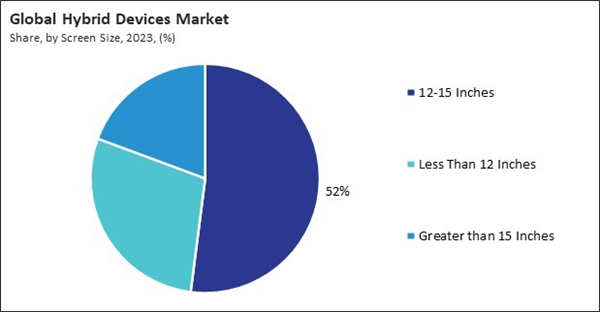The Global Hybrid Devices Market size is expected to reach $160.5 billion by 2031, rising at a market growth of 17.5% CAGR during the forecast period.
The North America region witnessed 34% revenue share in the hybrid devices market in 2023. This significant share can be attributed to several factors, including the region’s strong technological infrastructure, high consumer demand for versatile computing solutions, and a robust presence of major manufacturers and technology companies. The increasing adoption of these devices in North America is further fuelled by trends such as remote work and digital transformation across various industries, with consumers and businesses seeking devices that can provide both portability and functionality.
Today’s consumers seek devices that can adapt to various use cases. Whether for work, entertainment, education, or communication, performing multiple functions within a single device is increasingly attractive. These devices, which combine features of laptops, tablets, and smartphones, cater to this need by offering flexibility and convenience. This versatility allows users to switch between different tasks seamlessly, making these devices a preferred choice for many. In conclusion, the rising demand for versatile technology solutions drives the market's growth.
Additionally, As remote work and learning become commonplace, there is a growing demand for devices that can perform multiple functions efficiently. These devices, which blend the capabilities of laptops and tablets, provide the versatility needed for various tasks - from video conferencing and document editing to online research and creative projects. This adaptability makes them particularly appealing to professionals and students requiring a single device to meet all their needs. Therefore, remote work and learning environments are propelling the market's growth.
However, these devices, such as standard laptops or tablets, often come with a higher price tag than their traditional counterparts. This premium pricing is typically due to their advanced technology, multifunctionality, and the integration of various features. The initial cost can be a major barrier to adoption for budget-conscious consumers and small businesses, leading them to opt for more affordable, single-function devices instead. Thus, high initial costs and price sensitivity impede the market's growth.
The leading players in the market are competing with diverse innovative offerings to remain competitive in the market. The above illustration shows the percentage of revenue shared by some of the leading companies in the market. The leading players of the market are adopting various strategies in order to cater demand coming from the different industries. The key developmental strategies in the market are Acquisitions, and Partnerships & Collaborations.
The North America region witnessed 34% revenue share in the hybrid devices market in 2023. This significant share can be attributed to several factors, including the region’s strong technological infrastructure, high consumer demand for versatile computing solutions, and a robust presence of major manufacturers and technology companies. The increasing adoption of these devices in North America is further fuelled by trends such as remote work and digital transformation across various industries, with consumers and businesses seeking devices that can provide both portability and functionality.
Today’s consumers seek devices that can adapt to various use cases. Whether for work, entertainment, education, or communication, performing multiple functions within a single device is increasingly attractive. These devices, which combine features of laptops, tablets, and smartphones, cater to this need by offering flexibility and convenience. This versatility allows users to switch between different tasks seamlessly, making these devices a preferred choice for many. In conclusion, the rising demand for versatile technology solutions drives the market's growth.
Additionally, As remote work and learning become commonplace, there is a growing demand for devices that can perform multiple functions efficiently. These devices, which blend the capabilities of laptops and tablets, provide the versatility needed for various tasks - from video conferencing and document editing to online research and creative projects. This adaptability makes them particularly appealing to professionals and students requiring a single device to meet all their needs. Therefore, remote work and learning environments are propelling the market's growth.
However, these devices, such as standard laptops or tablets, often come with a higher price tag than their traditional counterparts. This premium pricing is typically due to their advanced technology, multifunctionality, and the integration of various features. The initial cost can be a major barrier to adoption for budget-conscious consumers and small businesses, leading them to opt for more affordable, single-function devices instead. Thus, high initial costs and price sensitivity impede the market's growth.
The leading players in the market are competing with diverse innovative offerings to remain competitive in the market. The above illustration shows the percentage of revenue shared by some of the leading companies in the market. The leading players of the market are adopting various strategies in order to cater demand coming from the different industries. The key developmental strategies in the market are Acquisitions, and Partnerships & Collaborations.
Driving and Restraining Factors
Drivers
- Rising Demand For Versatile Technology Solutions
- Growth Of Remote Work and Learning Environments
- Growing Adoption Of Cloud Computing Globally
Restraints
- High Initial Costs and Price Sensitivity
- Limited Performance Compared To Dedicated Devices
Opportunities
- Emergence Of 5g Technology Worldwide
- Increased Focus On Portability and Compact Designs
Challenges
- Compatibility Issues With Software and Applications
- Rapid Technological Advancements and Short Product Lifecycles
Type Outlook
Based on type, the hybrid devices market is divided into convertible and detachable. The detachable segment attained 43% revenue share in this market in 2023. Detachable devices are designed with a keyboard that can be completely removed from the screen, allowing the device to function as a standalone tablet. This design appeals to users prioritizing portability and touch interaction, particularly for media consumption, notetaking, and casual browsing.Screen Size Outlook
On the basis of screen size, the hybrid devices market is segmented into 12-15 inches, less than 12 inches, and greater than 15 inches. In 2023, the less than 12 inches segment attained 29% revenue share in this market. Devices in this category are favoured for their ultra-portability and lightweight design, making them ideal for on-the-go professionals, students, and casual users. While these smaller devices may have limited performance capabilities compared to their larger counterparts, they excel in convenience and ease of use for tasks such as browsing, notetaking, and media consumption.End User Outlook
Based on end user, the hybrid devices market is categorized into IT & telecom, personal use, educational institutions, healthcare, and others. The personal use segment witnessed 25% revenue share in this market in 2023. This segment encompasses a diverse range of consumers who seek devices that combine the functionalities of laptops and tablets for various everyday tasks. Personal use these devices are particularly popular for browsing, streaming, and light productivity tasks, appealing to users who value convenience and versatility. With lifestyle changes and an increasing preference for mobile computing, personal use devices have gained traction among a broad audience, from students and professionals to casual users.Regional Outlook
Region-wise, the hybrid devices market is analyzed across North America, Europe, Asia Pacific, and LAMEA. In 2023, the Europe region generated 32% revenue share in this market. This market performance reflects Europe’s growing emphasis on digitalization and technology integration into everyday life and business practices. European consumers increasingly seek flexible devices, especially in remote work and mobile learning environments. The rise of these devices in educational institutions across Europe has also played a crucial role in driving market growth as schools and universities adopt these tools to enhance the learning experience.Recent Strategies Deployed in the Market
- Oct-2024: Lenovo Group Limited unveiled its Smarter AI for All vision, featuring the Lenovo Hybrid AI Advantage, developed with NVIDIA. New products include the ThinkPad X1 2-in-1 Gen 10 Aura Edition laptop, the Lenovo AI Now personal assistant, and the AI-driven Lenovo Learning Zone for education.
- Oct-2024: Samsung Electronics Co., Ltd. teamed up with F45 Training to offer users access to various functional workouts through Samsung Daily+. This collaboration will provide free cardio, strength, hybrid, and recovery sessions, enhancing the at-home fitness experience while promoting user engagement and well-being through enjoyable, results-driven workouts.
- Jan-2024: Lenovo Group Limited unveiled new ThinkBook laptops and ThinkCentre desktops targeting the SMB market. Highlights include the ThinkBook Plus Gen 5 Hybrid with seamless laptop-tablet functionality, the carbon-neutral ThinkBook 13x Gen 4, and the advanced ThinkCentre neo-Ultra AI PC, showcasing Lenovo’s innovation and leadership in this segment.
- Oct-2023: Acer, Inc. unveiled its first Chromebook Plus laptops, the Chromebook Plus 515 and 514, featuring upgraded displays, cameras, and modern processors for enhanced productivity and multimedia experiences.
- Jun-2023: ASUSTeK Computer Inc. unveiled the BR1402 series, the first 2-in-1 rugged 14-inch laptops for K-12 education. Available in clamshell and convertible designs, these military-grade devices feature a 10-hour battery life, USB-C, WiFi 6, and modular upgrades, enhancing hybrid learning for modern students with a garaged stylus and a world-facing camera.
List of Key Companies Profiled
- Dell Technologies, Inc.
- Lenovo Group Limited
- Microsoft Corporation
- Toshiba Corporation
- Fujitsu Limited
- LG Electronics, Inc. (LG Corporation)
- Samsung Electronics Co., Ltd. (Samsung Group)
- Acer, Inc.
- ASUSTeK Computer Inc.
- Hewlett-Packard enterprise Company (HP Development Company L.P.)
Market Report Segmentation
By Type- Convertible
- Detachable
- 12-15 Inches
- Less Than 12 Inches
- Greater than 15 Inches
- IT & Telecom
- Personal Use
- Educational Institutions
- Healthcare
- Other End User
- North America
- US
- Canada
- Mexico
- Rest of North America
- Europe
- Germany
- UK
- France
- Russia
- Spain
- Italy
- Rest of Europe
- Asia Pacific
- China
- Japan
- India
- South Korea
- Australia
- Malaysia
- Rest of Asia Pacific
- LAMEA
- Brazil
- Argentina
- UAE
- Saudi Arabia
- South Africa
- Nigeria
- Rest of LAMEA
Table of Contents
Chapter 1. Market Scope & Methodology
Chapter 2. Market at a Glance
Chapter 3. Market Overview
Chapter 4. Competition Analysis - Global
Chapter 5. Global Hybrid Devices Market by Type
Chapter 6. Global Hybrid Devices Market by Screen Size
Chapter 7. Global Hybrid Devices Market by End User
Chapter 8. Global Hybrid Devices Market by Region
Chapter 9. Company Profiles
Companies Mentioned
Some of the leading companies profiled in this Hybrid Devices Market report include:- Dell Technologies, Inc.
- Lenovo Group Limited
- Microsoft Corporation
- Toshiba Corporation
- Fujitsu Limited
- LG Electronics, Inc. (LG Corporation)
- Samsung Electronics Co., Ltd. (Samsung Group)
- Acer, Inc.
- ASUSTeK Computer Inc.
- Hewlett-Packard enterprise Company (HP Development Company L.P.)
Methodology

LOADING...











